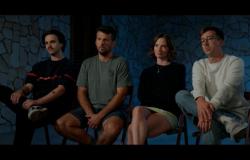Where the hell did all those images go? Over the past year and a half, that has been the most heard complaint in Middelheim. Work in progress, was the standard answer. The museum is renovating.
Now that the work has been completed, the first impression is that of a major moving operation. Some interventions are quite far-reaching. The oldest part of the sculpture park, immediately past the entrance, had the largest number of crowd favorites, but now shows a completely empty lawn. It will be the permanent place for temporary exhibitions in the future. Elsewhere too, the green environment is gaining the upper hand and the range of images has been considerably reduced. Many sculptures from the permanent collection moved to a new open-air depot. They remain accessible, but they are all clumped together.
Softening
A makeover operation was needed. The open-air museum dates back to the 1950s and has continued to grow ever since. Until the end of the last century, images were often placed randomly, each on their own island of meaning and without much coherence.
The park landscape, a natural heritage on the edge of the city, also required an upgrade. Large parts have now been softened, greened and made more climate-robust. To draw up the master plan, the architects of Studio Moto worked together with a landscape architect and the Antwerp green department. In the ‘garden part’ of the park alone, approximately 3,000 square meters of walking paths were paved.
‘Odyssey’ by Bernard Rosenthal. — © Katrijn Van Giel
More than 200 works were given a new arrangement, often in a different park zone. They are grouped chronologically or encyclopedically, but brought together in four thematic clusters. If you complete the entire course, you will cover 2.5 kilometers.
The ensembles all evoke how people relate to their environment. For example, there is a group of works on ‘movement’: how nature changes according to the seasons, and how the cycle of life is an echo of this. You will find work from Alexander Calder to Henk Visch, from Ossip Zadkine to Anne-Mie Van Kerckhoven.
Reception pavilion
Recent acquisitions were added, on loan from the Flemish Community, including Philip Aguirre y Otegui, Kasper De Vos and Filip Vervaet. For a number of works the moment was ripe for restoration, such as the large brick sculpture by Per Kirkeby that suffered storm damage in 2022. Bernd Lohaus’s installation, affected by fungi, was given a new exhibition copy. And the sleek columned pavilion by the Liège architect Charles Vandenhove revealed that it was also intended to exhibit sculptures. Of Grande bagnante Emilio Greco now gave it a playful, contrasting addition.

© Katrijn Van Giel
The Middelheim Museum also worked on better accessibility and signage. So there is now a new starting point. The former coach house, in the courtyard, was transformed into a feather-light reception pavilion and shop.
The collection pavilion, which was only opened to the public as a ‘viewing depot’ in 2019, will also be updated. For example, there is a selection of vulnerable works on the Flemish masterpieces list, by artists such as Alberto Giacometti and Alexander Archipenko. Half of the pavilion is reserved for the library collection, often with artists’ books that are an object in themselves. Between the racks you will discover video and photo images of Ana Mendieta and Liliane Vertessen.
Henry Moore
The biggest innovation can be found in the Hortiflora, a former flower garden of the Nachtegalenpark, which was incorporated into Middelheim in 2012. From now on, it will form the beating heart of the museum, where the permanent collection is given a new interpretation with intimate encounters in living room style.
The question that many visitors will ask themselves: aren’t historical key works of an open-air museum inextricably linked to their location? Can you separate them from their fixed location and from the image that goes with it?

© Katrijn Van Giel
Works created in situ continued to be respected. The thorough exercise of the collection team also shows that a relocation can provide added value. This is most noticeable with the seated pair of statues King and Queen by Henry Moore, which until recently was located at the central entrance. In its new location in Hortiflora it is more approachable and it suddenly appears to have a graceful back. The Orpheus van Zadkine, previously condemned to a lost corner, is given a different focus here.
The museum team did not act overnight. She also relies on archival research for new lectures. Instructions from Rik Wouters’ widow clearly indicate that The crazy violence at eye level, so on a lower plinth. Also the Balzac by Rodin, who you can see towering over a hedge in the distance, comes closer from his lower perspective.
Yet there is still work to be done. It is unclear what role will be reserved for the Braem Pavilion in the future, or for the semi-open pavilion Het Huis, where only a sound artwork by Louise Lawler can now be heard. We should see the renovation as a starting point, says director Sara Weyns. “It represents a new beginning, an invitation to a new dialogue with visitors.”
Tags: start Middelheim drastic renovation
-





